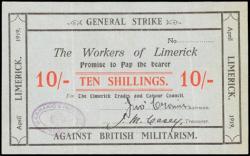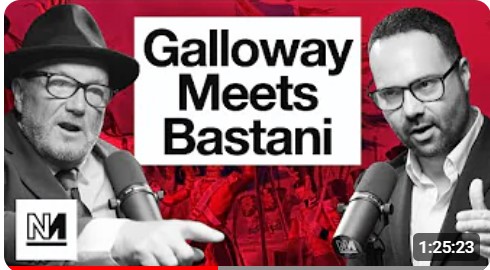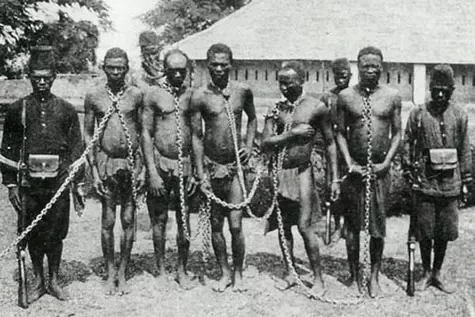by Finbar Geaney, member, Irish Labour Party and the Executive Committee of the Dublin Council of Trade Unions
2019 is the 100th anniversary of the Limerick General Strike also known as the Limerick Soviet. Soviet, for those who might not know, is the Russian word for Council. There will be many planned events in Ireland celebrating this historic action when the working class of Limerick in the South West of Ireland, controlled that city for 12 days in 1919. We share this account in commemoration of that great event in working class history.
Much of the current discussion about Ireland’s ‘War of Independence’ is presented in purely military terms, with the principal focus being on particular individuals and certain military confrontations. But the independence struggle that took place in the 1918-1922 period encompassed far more than military actions. Strikes by workers employed in the munitions industry and in transport played a major role. In addition, the Labour Party and Trades Union Congress called a national general strike demanding the release of political prisoners.
A series of major strikes took place in cities such as Belfast, Dublin, Cork and Ballina. In 1920 alone 233 strikes were recorded. Many of the disputes of this period spread to town and city-wide mobilisations. A dozen or so of these disputes were carried on under the red flag of revolution and came to be known as Soviets, after the example of the Russian Revolution of 1917. This article will focus on the Limerick General Strike that broke out in April 1919 and which has come to be known as the Limerick Soviet.
Limerick the fourth largest city in Ireland
The Limerick General Strike lasted from 14th until 26th of April 1919. During that time Limerick, situated in the South West of the country and the fourth largest city in Ireland, was in effect run by the Limerick Trades Council. Transport in the city was allowed to function only with the permission of the Council. Likewise, shops required the permission of the Trades Council in order to trade. Cinemas, if they opened, had to display a sign stating that they were working under the authority of the Strike Committee.
Other Trades Councils and some individual trade unions contributed money to the Strike Committee. Initially the strike was supported by the Irish Labour Party and Trade Union Congress. The leader, Thomas Johnson, assisted the Strike Committee in producing special banknotes, in three separate denominations – five shillings, ten shillings and one pound – that were used during the strike. Financial contributions were made by the Gaelic Athletic Association and many other organisations and individuals, including some priests.
Botched attempt to rescue Robert Byrne
The immediate cause of the strike was the declaration on April 11th, 1919 by the British military authorities that the Borough of Limerick was to be placed under martial law. This measure was the response of the British Government to a botched attempt to rescue Robert Byrne, a telegraph operator and a well-known member of the Trades Council, who had been transferred under police guard from Limerick Prison to Limerick Workhouse Hospital. Byrne, a member of the Volunteers, was sacked from his job for union activities and was sentenced by a British Army court martial to twelve months imprisonment with hard labour for possession of a revolver. He and other prisoners in Limerick jail went on hunger strike in a quest for political status. The Limerick United Trades and Labour Council had already passed a resolution the previous February protesting against the treatment of political prisoners.
General strike begins in Limerick
Byrne was killed in the rescue attempt, as were two police constables. 10,000 people marched at the removal of Robert Byrne’s body. The funeral route was lined by British troops with fixed bayonets. Limerick was declared by the military authorities to be a proclaimed area. Anyone wishing to enter the city was required to carry a permit issued by the Royal Irish Constabulary. Workers coming to and from their jobs, who had to cross into or out of the proclaimed area, were subject to the restrictions. Routes into the city were blocked with barbed wire and military units. Between five and six thousand workers were directly affected.
Following a meeting of Limerick’s United Trades & Labour Council, which brought together delegates from thirty-five trade unions in the city, it was decided unanimously to call a general strike that would begin on Monday, April 14th. Workers at the Condensed Milk Company had already taken strike action on the issue. Fifteen thousand workers were involved. All production, retail and transport came under the strike order. So too did hotels, banks, Government business and the Post Office. Railway workers supported the strike and refused to handle freight for the city unless sanctioned by the Strike Committee.
Commercial transport functioned at behest of strike committee
The Trades Council formed itself into a Strike Committee, which took over a printing press in the city in order to publicise its actions through the production of placards, information sheets and a Strike Bulletin. Permits that allowed firms to operate under the direction of the Strike Committee were also produced. Lists of food prices were published in an effort to prevent profiteering. Retail prices were fixed, and profiteers were closed down. Some bakeries were permitted to maintain production under Trades Council licence, as were some butchers and coal merchants. Whatever commercial transport that was allowed could only function with the permission of the Trades Council. The Strike Committee also provided staff to maintain essential services such as gas, electricity and water supplies. Public Houses were shut for the duration of the strike.
The Strike Committee ensured that supplies of food were brought to the city from farmers in Clare on the north of Limerick city. Food was also promised from other parts of Ireland and from the UK. There was no looting and no cases were brought before the courts during the period of the strike.
During the strike several imaginative ways to sidestep the permit restriction were employed by local people, such as crossing the River Shannon by boat or walking across railway tracks or by large crowds congregating at check-points causing confusion for the military. The British army fired shots occasionally in an endeavour to stop anybody without a permit.
In effect the organised labour movement in Limerick became the sovereign power in the city for a period. The Irish Times described the situation as a ‘Soviet’, because of similarities between events in Limerick and other parts of Europe that were in revolutionary turmoil at that time.
Sinn Fein marginalised in Limerick City
Alarmed at the potential for workers’ power in the city, and at the possibility of the movement spreading to other parts of the country, the Limerick Chamber of Commerce called upon the British Government to withdraw the permit system.
During the period of the Soviet the Sinn Féin Party was marginalised in Limerick city. Sinn Féin did not favour the development of an independent socialist or workers’ movement in the country. Local Sinn Féin leaders supported the strike, but the Sinn Féin party were anxious not to alienate business and large farming interests. During the struggle for independence the party made several interventions to derail independent class actions and occupations. Sinn Féin did not want the Limerick strike to escalate.
The Limerick Soviet came to be widely publicised because many of the world’s press were present in the city at the time to report on a transatlantic air race that involved landing and refuelling in a field outside the city. Reporters working on this event were required to submit to the authority of the Strike Committee.
British-based NUR refused to support the strike
A number of organisations were opposed to the strike action from the outset. The National Executive Committee of the UK-based National Union of Railwaymen instructed its members not to support the strike, even though railwaymen in the city and country had been taking action in support. The British TUC told its affiliated unions not to provide strike pay to any of its members involved in the strike. The principal concern of the British labour leaders was that the issue in Limerick had spread beyond the initial demand for the lifting the permit system and was becoming a ‘political’ strike. However, Limerick’s workers were supported by the Independent Labour Party and by the British Socialist Party.
On April 20th, six days into the strike, members of the National Executive Committee of the Irish Labour Party and TUC came to Limerick to discuss events with the Strike Committee. Others arrived during the following few days. Sean Cronin, Chairman of Limerick United Trades and Labour Council proposed that Limerick become the headquarters of Ireland’s national and social revolution. He had hoped that the national labour leaders would extend the struggle to other parts of the country. The involvement of the railwaymen was a key aspect of this demand. But the national labour leaders were unwilling to take that course. On April 23rd they insisted that they had no authority to call a national General Strike without a special conference of the Party and Trade Union Congress. But why then did they not call such a conference! In their anxiety to avoid a direct confrontation with the State and its forces they proposed an absurd tactic – the city would be abandoned by its citizens, leaving the military authorities with an empty shell. The Strike Committee rightly rejected this proposal.
Striking workers becoming isolated
Shortly thereafter the workers were abandoned by the national labour leaders. However, Thomas Johnson visited Limerick again to speak at a rally supporting continuation of the strike and called for a special conference of the Labour Party and TUC. But in effect the striking workers were now becoming isolated. The Bishop of Limerick, the Mayor, local business interests and the General Officer Commanding British forces met together to examine ways in which the strike could be ended. The Catholic priest William Dwan denounced the strike from his pulpit. A deal was struck whereby this coterie of conspirators agreed to seek the ending of the Soviet, with the promise that, within a week following that, the Military Permit Order would be lifted.
Some strike notices were then withdrawn but for many workers the strike continued. Only half the striking workers returned initially. Some confrontations between workers took place in endeavours to prevent people from seeking military permits. But eventually the Strike Committee declared that the Limerick General Strike was at an end. A week later the proclamation was lifted.
Issues raised went far beyond the original strike
The Limerick Soviet was an example of the organised labour movement in Ireland coming to the fore during the struggle for independence. There were to be many other examples of major class actions across the country. During the twelve days of the Limerick strike the issues raised had spread far beyond the immediate cause of the dispute. The United Trades and Labour Council in the city showed how the organised labour movement could create an alternative way of running society, based on cooperation and workers’ control. The question of dual power was posed. Who runs society, the organised labour movement or the capitalist government! But the failure to extend the strike beyond the confines of the city made it easier to defeat.
Unlike the Soviets in Russia in 1917, there was no organised system of factory and workplace committees around the Strike Committee that would maintain accountability over decisions. This made it easier for the leaders to retreat The Intervention by right-wing labour leaders in the UK, such as J.H. Thomas of the National Union of Railwaymen worked to undermine the dispute. The British Government was concerned for its empire. Likewise, the Catholic hierarchy strove to prevent the movement from spearheading a movement towards the creation of an alternative way of running society. The principal objective of all the conservative forces was to stop any movement that was going in the direction of socialism.
But, the workers of Limerick lit a beacon in 1919. The organised labour movement demonstrated what was possible, and the example was picked up in many other areas of the country. However, the absence of a revolutionary labour leadership nationally allowed the struggle for independence to fall into the hands of conservative, nationalist forces.
April 2, 2019



